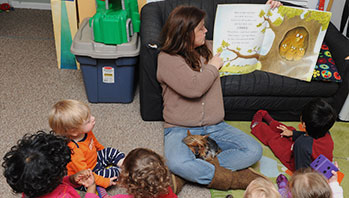- flower
- leaf
- part
- plant
- root
- stem
MA Standards:
Literature/RL.PK.MA.1: With prompting and support, ask and answer questions about a story or a poem read aloud.
Literature/RL.PK.MA.4: With prompting and support, ask and answer questions about unfamiliar words in a story or poem read aloud.
Literature/RL.PK.MA.9: With prompting and support, make connections between a story or poem and one’s own experiences.
Literature/RL.PK.MA.10: Listen actively as an individual and as a member of a group to a variety of age-appropriate literature read aloud.
Head Start Outcomes:
Literacy Knowledge/Book Appreciation and Knowledge: Asks and answers questions and makes comments about print materials.
Literacy Knowledge/Alphabet Knowledge: Recognizes that the letters of the alphabet are a special category of visual graphics that can be individually named.
PreK Learning Guidelines:
English Language Arts/Reading and Literature 6: Listen to a wide variety of age appropriate literature read aloud.
English Language Arts/Reading and Literature 7: Develop familiarity with the forms of alphabet letters, awareness of print, and letter forms.
English Language Arts/Reading and Literature 10: Engage actively in read-aloud activities by asking questions, offering ideas, predicting or retelling important parts of a story or informational book.
Read Together: Eating the Alphabet #1

© Commonwealth of Massachusetts, Department of Early Education and Care (Jennifer Waddell photographer). All rights reserved.
STEM Key Concepts: There are many different types of plants; Many foods that animals, including humans, eat come from plants; We eat certain leaves, roots, fruits, and seeds
ELA Focus Skills: Listening and Speaking, Vocabulary
Before You Read
Show children the cover of the book. Point to the words as you read aloud the complete title and the name of the author and illustrator. Ask children to name the different fruits and vegetables they see on the cover. Explain that this is an alphabet book about different foods. Set a reading focus for children by having them identify what part of the plant each food is from.
As You Read
As you move through the pages, point to the letter before you read the rest of the page. Ask children to say the name of the letter if they recognize it.
- Pause on each page and have children identify foods they recognize. Have them describe what they know about the food (taste, feel, smell, etc.) Then point to and read the names of each fruit and vegetable.
- Pause on spreads and point to a food and ask children what part of the plant it is from. (asparagus/stem; carrot/root; cabbage/leaf; broccoli/flower; etc.)
After You Read
Talk with children about the book. Ask questions such as,
- Did you see any of your favorite foods in the book?
- What is one food you saw in the book that you think animals will eat? Why do you think that?
- Why do you think the title of the book is Eating the Alphabet?
Take It Further: Turn to the glossary pages and tell children that these pages list all the plants in the book. Say, These pages also tell us where in the world many of the plants come from. Ask children if they remember any of the plants that were introduced in Chicks and Salsa. If children do not recall any plants from the book, point out a few and the native country or region, for example, avocado/Mexico, onion/SW Asia, jalapeno/Mexico. You may want to point out some of the foods that are native to North America (blueberry, corn, huckleberry).
Cultural Connection: Allow children from different areas to identify foods that are part of their family’s culture. Ask them to describe how the food tastes, smells, and feels, and how their family uses the food in recipes at home.
Adaptation: For this first reading you may want to have children identify only the fruits and vegetables they know. Then, at a later date, return to the book and read the names of all the foods shown.
Adaptation: For centers with young children, you may want to focus on specific letters and only read those pages. Then return to the other pages at a later date.
Adaptation: If young children have trouble concentrating as you move through the book, read a few pages and return later to read more.
Adaptation: Challenge older children to name another fruit or vegetable for each letter.
